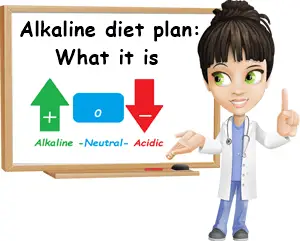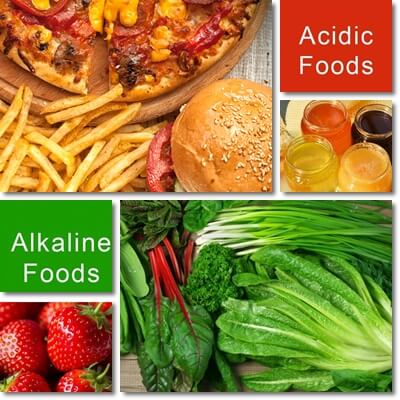The alkaline diet is a new concept of eating that aims to restore and preserve good health through clean, healthy eating. In its essence, this diet plan classifies foods by the trace they leave in our body, which can be either alkaline or acidic, hence the concepts of alkaline foods and acidic foods. The diet works based on the notion of pH, a measurement of alkalinity and acidity used in chemistry. The aim, according to the initiators, is to have an intake as high as 80% of alkaline foods and as low as 20% of acidic foods in order to enjoy good health.
What is the alkaline diet more specifically? Also known as the acid-alkaline diet or the alkaline-ash diet, the diet plan refers to eating based on food pH. But here is where it might get a bit confusing: the pH of some foods may be different before eating them compared to after eating them. Certain foods are acidic before we eat eat and digest them. Lemons for example are acidic foods and we know this from the start because of their taste. However, after being digested, they leave an alkaline trace in the body, hence the reason they are really alkaline-forming foods and theoretically good for us. So the diet revolves around eating according to the pH foods have following digestion.

What is pH? In short, pH, meaning the potential of hydrogen, is a scale used in chemistry to measure alkalinity and acidity of solutions and ranges from 0 to 14. The pH scale is as follows: 0 (extremely acidic) – 7 (neutral) – 14 (extremely basic, or alkaline). This measurement is also applicable to food and the human body. Our blood, the liquid inside our cells, the fluid in our brain and spine, our pancreas secretions are all alkaline, while our stomach acid, skin and urine are acidic.
According to the theory of alkalinity, it’s the blood pH that matters because, well, blood takes on an impressive amounts of functions and travels throughout our body, being in direct contact with organs, systems and cells. Our blood has been shown to have a mildly alkaline pH of around 7.35-7.45. Moreover, it appears to have a self-regulatory mechanism to keep itself this way. The theory considers that eating alkaline foods helps our blood remain alkaline too, so we should eat according to its pH to support its natural tendency for alkalinity.
How does the alkaline diet work? The reason behind why we would need to eat mostly alkaline-forming foods is to help maintain our blood pH. It has been theorized that, by eating according to our blood pH, we would be actively contributing to maintaining its slight alkalinity because alkaline foods leave an alkaline trace in the body. By eating against it, meaning more acidic foods than alkaline ones, our body would have to deal with too much acidity which would eventually alter normal blood pH, making it acidic too. What the ash alkaline diet basically says is that our blood and other fluids pH is and can be conditioned by what we eat (which is also the idea some experts and traditional medical professionals dispute, saying that blood and other fluids pH is not regulated by what we eat).

Why is the alkaline diet good for us?
In the alkaline theory of eating, foods with an alkaline pH are healthy because they correspond with the (mildly) alkaline pH of our blood. Acidic foods are believed to leave behind acidic residues that may influence said pH and somehow go against our nature, thus being a source of disease. Based on the theory, it is recommended to have a considerably higher intake of alkaline foods compared to acidic ones: an 80 to 20 ratio. This means eating mostly alkaline foods and having a very low intake of acidic foods, just to maintain balance because an excessively alkaline blood pH is not good for us either, according to the diet.
However, some experts consider that while what we eat does influence our health immensely, it has no effect on our blood pH, advancing the idea that the proposed mechanism of action of the alkaline-acid diet is not functional or real. According to them, our blood pH remains alkaline due to a self-regulatory mechanism, not as a result of what we eat. In support of this argument, they give as example other body fluids such as urine which is acidic because the kidneys take care of eliminating the acidic traces some foods leave in our body after digestion. Even if we didn’t eat mostly alkaline foods, our kidneys would still eliminate acidic elements so that our blood would still be mildly alkaline.
At the same time, it is true that having a high intake of meat, dairy and even grains, not to mention processed and junk food has been shown to encourage the onset of chronic disease over time, but this has been shown to occur for other reasons than supposedly turning our blood acidic. For example, animal products are too rich in fat and a high intake leads to lipids setting on the inside of artery walls, blocking normal blood flow and causing high cholesterol, arterial calcification and cardiovascular events. A too high of an intake of grains can lead to a higher intake of anti-nutrients such as fiber, phytic acid and others, exposing us to nutritional deficiencies and disease. Examples are numerous.
The ash alkaline or acid alkaline diet may present itself as groundbreaking, but it nonetheless promotes eating habits at least similar to our traditional notions of healthy eating. As you can see in the most accurate of alkaline acid charts, most alkaline foods are foods we are normally recommended by our doctors and nutritionists. Broccoli, leafy greens such as spinach, carrots, radishes, almonds, pine nuts, bananas, figs, lime, lemon, sour cherries or watermelon are all alkaline, but also healthy foods when seen from a more traditional perspective on nutrition (for more information on the properties and benefits of fruits, vegetables, honey, oils and other foods, feel free to visit the Foods Map).
Meat and dairy, fish and grains, which we are normally advised to eat in moderation, are often acidic. Similarly, traditional diets and medical professionals urge us to exclude junk food from our diets because it doesn’t have real nutritional value, coinciding with the alkaline ash diet recommendations. Considering the fact that what we eat affects our health one way or another, it would seem normal that an alkaline diet would be beneficial for us, considering that alkaline-forming foods generally coincide with the more traditional notions of healthy or functional foods.
Conclusion
While the benefits of an alkaline diet are not conclusively and irrefutably supported by scientific evidence, a quick look at food pH shows us that the foods we know are healthiest are alkaline, while those we know to be the unhealthiest are acidic. So when our doctors and nutrition experts tell us to eat more fresh fruits and vegetables and less meat, dairy or grains as well as avoid processed foods, they are basically telling us to eat more of the alkaline-forming foods and less of the acidic-forming foods, given the fact that the two notions of healthy eating happen to coincide. It’s not on which foods are healthy and which are not that traditional medicine and the supporters of the alkaline-ash diet have different views, but on how exactly this new diet works.
But whether you are a believer or just an objective observer who notices the alkaline diet overlaps with the more traditional recommendations regarding healthy eating, the alkaline-acidic charts of fruits, vegetables, nuts, seeds, dried fruit, cereals, meat and dairy products in the menu above will surely be of use to you because they indicate the healthiest foods to eat both according to the alkaline acidic diet and according to current nutritional standards.
